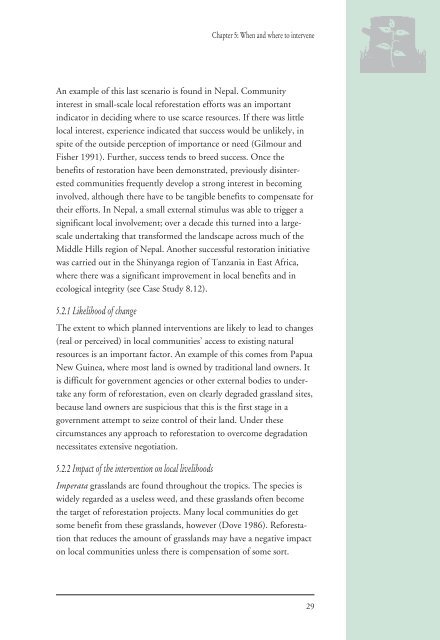Rehabilitation and Restoration Of Degraded Forests (PDF) - IUCN
Rehabilitation and Restoration Of Degraded Forests (PDF) - IUCN
Rehabilitation and Restoration Of Degraded Forests (PDF) - IUCN
You also want an ePaper? Increase the reach of your titles
YUMPU automatically turns print PDFs into web optimized ePapers that Google loves.
Chapter 5: When <strong>and</strong> where to intervene<br />
An example of this last scenario is found in Nepal. Community<br />
interest in small-scale local reforestation efforts was an important<br />
indicator in deciding where to use scarce resources. If there was little<br />
local interest, experience indicated that success would be unlikely, in<br />
spite of the outside perception of importance or need (Gilmour <strong>and</strong><br />
Fisher 1991). Further, success tends to breed success. Once the<br />
benefits of restoration have been demonstrated, previously disinterested<br />
communities frequently develop a strong interest in becoming<br />
involved, although there have to be tangible benefits to compensate for<br />
their efforts. In Nepal, a small external stimulus was able to trigger a<br />
significant local involvement; over a decade this turned into a largescale<br />
undertaking that transformed the l<strong>and</strong>scape across much of the<br />
Middle Hills region of Nepal. Another successful restoration initiative<br />
was carried out in the Shinyanga region of Tanzania in East Africa,<br />
where there was a significant improvement in local benefits <strong>and</strong> in<br />
ecological integrity (see Case Study 8.12).<br />
5.2.1 Likelihood of change<br />
The extent to which planned interventions are likely to lead to changes<br />
(real or perceived) in local communities’ access to existing natural<br />
resources is an important factor. An example of this comes from Papua<br />
New Guinea, where most l<strong>and</strong> is owned by traditional l<strong>and</strong> owners. It<br />
is difficult for government agencies or other external bodies to undertake<br />
any form of reforestation, even on clearly degraded grassl<strong>and</strong> sites,<br />
because l<strong>and</strong> owners are suspicious that this is the first stage in a<br />
government attempt to seize control of their l<strong>and</strong>. Under these<br />
circumstances any approach to reforestation to overcome degradation<br />
necessitates extensive negotiation.<br />
5.2.2 Impact of the intervention on local livelihoods<br />
Imperata grassl<strong>and</strong>s are found throughout the tropics. The species is<br />
widely regarded as a useless weed, <strong>and</strong> these grassl<strong>and</strong>s often become<br />
the target of reforestation projects. Many local communities do get<br />
some benefit from these grassl<strong>and</strong>s, however (Dove 1986). Reforestation<br />
that reduces the amount of grassl<strong>and</strong>s may have a negative impact<br />
on local communities unless there is compensation of some sort.<br />
29

















